 |
UA Bundle SDK .NET
2.5.2.385
|
 |
UA Bundle SDK .NET
2.5.2.385
|
To connect to a server, a client needs information like network address, protocol, and security settings. For this purpose, OPC UA defines a set of discovery features.
All information which is required to establish a connection between client and server is stored in a so-called endpoint. A server can provide several endpoints, each containing
If several OPC UA servers exist, a Discovery Server can be used to provide information of available servers. Servers can register at the Discovery Server. Clients may then request a list of all available servers from the discovery server and then use the GetEndpoints service to get connection information from a server.

The initial configuration on client and server side, the different options to find available servers, and the connection establishment between client and server is described in the following sections.
To identify itself to communication partners, each installed OPC UA application or devices needs an Application Instance Certificate and an associated public/private key pair. The public key is distributed with the certificate. The private key has to remain secret and is used to sign and/or encrypt messages. A communication partner can use the public key to verify the trust relation, check the signature of messages, and encrypt messages. The Application Instance Certificate, including the public and private key, can either be generated by the application or provided by an administrator.
Certificates are filed in a Certificate Store, containing separate locations for trusted and own certificates, as well as certificates from certificate authorities used to verify certificate chains. An additional rejected location may contain certificates of applications that tried to connect but are not trusted yet.
Certificates issued by the application are called self-signed certificates. They are typically generated during installation of the application or at first start. To establish a trust relation between an OPC UA client and server, the self-signed certificates of the communication partner are installed to the trust list. The client certificate is installed to the trust list of the server and the server certificate to the trust list of the client. If the certificate of an application is removed from the trust list, a communication establishment is no longer possible.
Certificates signed by Certificate Authorities (CA) enable central trust management for a group of OPC UA applications or devices. In this case, just the CA certificate must be installed to the trust list of the OPC UA applications. After the CA certificate is installed, all other applications with certificates signed by the CA are able to communicate with each other. To be able to exclude previously trusted applications from the communication, the CA maintains a Certificate Revocation List (CRL). Each installed CA certificate must have an associated, up-to-date CRL installed. This CRL is required for a verification of the trust relation. The OPC UA Global Discovery Server definition provides a mechanism for central management of CA signed certificates and update of the corresponding CRLs. CA certificates can build a chain, e.g. a root CA for a company, a CA for a site where the site CA is signed by the root CA and a CA for a production line in the site. An OPC UA application in the production line would only trust the CA for the production line. The other CA certificates are only used to verify the chain.
A file based certificate store contains the following directories. Names and structure may differ between applications.
In addition, there is typically a Rejected directory where the OPC UA application can store certificates from other OPC UA applications that tried to connect but were not trusted. Administrators can move certificates from Rejected to Trusted if the application is allowed to connect.
As an example, let’s look at a production line where ServerX, ClientY, and ClientZ need to communicate with each other. In the simplest case, a single certificate authority (CaLine1R) manages the central certificate management of the production line (and is thus the root CA). ServerX, ClientY, and ClientZ are all signed by CaLine1R (see figure below). To trust each other, it’s only necessary to install the certificate and the associated certificate revocation list of CaLine1R.

In a more complex set-up, e.g. if production line 1 is part of a larger plant consisting of more than one line, itself being part of a company having several production sites, there may be more than one certificate authority, altogether forming a certificate chain (see figure). CaLine1 is signed by CaPlantA (the production site’s certificate authority), which in turn is signed by CaRoot (the company’s root certificate authority). Each of these CAs keeps its own certificate revocation list.

The following figure exemplarily shows the content of a file based certificate store for ClientX in the above mentioned scenarios. In both cases, the directories own look identical: The subfolder certs contains the client’s own certificate ClientX.der and private contains the private key ClientX.pem.
The content of the folders trusted is similar in both cases: certs contains the certificate of the trusted certificate authority (i.e. the CA signing the applications to trust): CaLine1R.der in the simple case without certificate chain, and CaLine1.der in the more complex case. The associated certificate revocation list CaLine1R.crl (simple case) or CaLine1.crl (certificate chain example) has to be placed into the subfolder crl.
If there’s no certificate chain, the folder issuers remains empty. If there is a certificate chain, issuers has to contain all certificates needed to validate the complete chain in the subfolder certs, and one and only one certificate revocation list for each certificate authority in the folder crl. In our example above, we have two superordinate certificate authorities: CaPlantA and CaRoot. Thus, the folder certs contains the certificates CaPlantA.der and CaRoot.der, and the folder crl contains the certificate revocation lists CaPlantA.crl and CaRoot.crl.

The following figure shows the initial configuration of a server after installation.
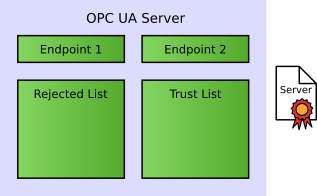
The configuration consists of
A server has to provide (at least one) endpoint(s) where clients can connect to. A client uses the Discovery URL (normally identical to the Endpoint URL) to request the list of endpoints including the security configuration from a server. This request through the GetEndpoints service always works without security. The Discovery URL is normally provided by Discovery servers.
The Endpoint URL provides the basic information that clients need to connect to a server, including the protocol, the host name or IP address, and the port number, e.g. opc.tcp://localhost:48020. In addition, the client needs to know the following security options configured on the server.
OPC UA defines Security Policies and a unique URI for each policy:
| Security Policy | URI |
|---|---|
| Basic256Sha256 | http://opcfoundation.org/UA/SecurityPolicy#Basic256Sha256 |
| Basic256 | http://opcfoundation.org/UA/SecurityPolicy#Basic256 |
| Basic128Rsa15 | http://opcfoundation.org/UA/SecurityPolicy#Basic128Rsa15 (no longer considered as secure) |
| None | http://opcfoundation.org/UA/SecurityPolicy#None |
Three Message Security Modes are supported:
Currently, OPC UA supports the following User Identity Token Types
A typical set of endpoints could be:
| Endpoint 1 | Endpoint 2 |
|---|---|
|
|
Servers may register at so-called Discovery Servers so that they can be discovered by clients. The registration process is described further on for the different Discovery options.
A Local Discovery Server (LDS) on a network node is only necessary if more than one OPC UA server is available, e.g. on a Windows PC with several OPC UA servers installed. In this case, the LDS is listening on port 4840, which is the IANA registered port for OPC UA. OPC UA clients start the discovery process with FindServers using this port.
OPC UA servers on devices or other systems with just one server use port 4840 directly. There is no need for a LDS in this case. Every OPC UA server implements the FindServers service returning itself.
The following figure shows the initial configuration of a client after installation:
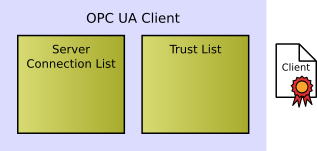
The configuration consists of
A client can find servers using the different Discovery options and retrieve the information it needs to connect to a server via the OPC UA service GetEndpoints. To avoid having to repeat this Discovery process before each connection attempt, most clients will store the server endpoint information for a configured server.
Once a client has found the server it intends to connect to, the client is able to call GetEndpoints. The server returns a list of endpoints it provides, including the security configuration (see above) as well as its certificate (including the server’s public key).

For being able to establish a secure connection to the server, the client has to trust the server’s certificate, i.e. the certificate has to be added to the trust list. Usually, a dialog window will open and prompt the user to examine the certificate and decide whether it should be trusted.
The following screenshot shows the respective dialog window in UaExpert when trying to connect to a server for the first time. It displays the content of the server’s certificate and allows the user to decide whether to trust the certificate or not. If the user chooses “Trust Server Certificate”, it is stored in the folder trusted/certs in UaExpert’s PKI certificate store.
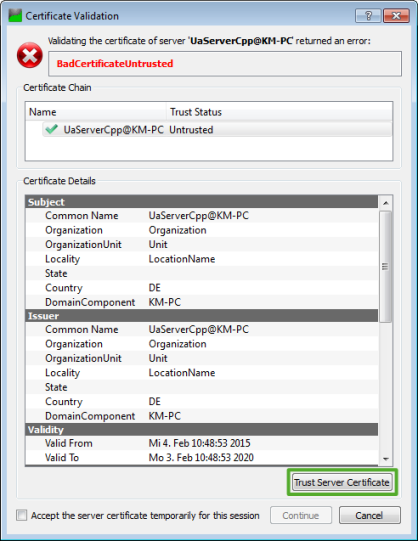
Having trusted the certificate, the client is able to check the signature of messages from the server and encrypt messages to be sent to the server. After saving the endpoints to the server connection list, the client configuration is finished.
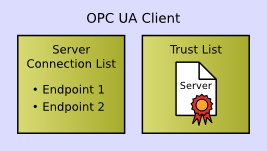
Now the client can attempt to create a secure channel with the server, sending along its Application Instance Certificate (including the public key of the client). This first connection attempt will be rejected, because the server doesn’t trust the client yet.

Trusting the client’s certificate is a manual step on the server. Usually, a server administrator has to move the client certificate from the list of rejected to the list of trusted certificates.
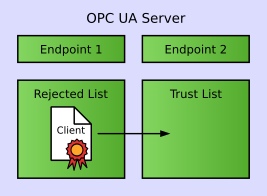
When using the C++ SDK Demo Server, this can be done using the administration tool as shown in the following screenshot. The “Certificates” tab lists the certificates in the server’s Certificate Store. Certificates from the Trusted directory are shown as trusted and the certificates from the Rejected directory are shown as untrusted. UaExpert’s certificate is shown as “Untrusted”. Right clicking on the certificate and choosing “Trust” from the context menu moves the certificate from the folder rejected to trusted/certs in the server’s Certificate Store.
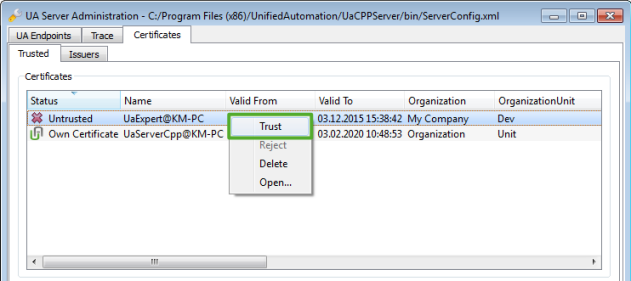
After this step, the server is configured.
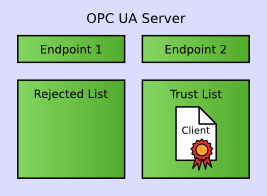
The next attempt of the client to create a secure channel will succeed, and it is able to create and activate a session with the server.

Before a client can connect to a server, it needs to collect information. Therefore, OPC UA defines three different discovery options:
If a client does know that there are OPC UA servers running on a certain host, but doesn’t have detailed connection information, it can construct a connection URL from the host name and the standard OPC UA port 4840 (e.g. opc.tcp://localhost:4840 or opc.tcp://targetHost:4840). This URL is then used to connect to the discovery server and to call FindServers.
If more than one OPC UA server is installed on a system, a Local Discovery Server (LDS) is running on port 4840. The LDS maintains a list of available servers which may be used by servers to announce their existence to clients.
To be visible for local discovery, servers have to register at the LDS using either the RegisterServer2 or the RegisterServer service. The registration with the LDS requires security configuration. Therefore, the server certificate must be installed in the trust list of the LDS.

If only one server is installed, a separate LDS is not necessary and the server itself will use the port 4840 and will respond to FindServers returning itself.
For situations where the client doesn’t know the available servers on the network, OPC UA defines the use of mDNS, a standardized multicast extension to DNS also known as zeroconf. mDNS defines mechanisms for name resolution without a central DNS server as well as service discovery functionality. This ad-hoc discovery typically works only within a subnet.
For regular OPC UA applications, the functionality is provided by Local Discovery Servers with multicast extension (LDS-ME). Servers registered with the LDS are automatically announced via LDS-ME. Servers registered with RegisterServer2 can also provide a list of server capabilities that can be used for filtering the list of available servers.
Another feature of an LDS-ME is the creation of a local cache with OPC UA servers announced via mDNS.
Clients can retrieve this list by calling the service FindServersOnNetwork on the local LDS-ME.

The OPC UA Global Discovery Server (GDS) concept allows the configuration of a network wide discovery of OPC UA servers that is not limited to a subnet like mDNS. In addition, it provides functionality for central certificate management including the distribution of CA signed certificates and related Certificate Revocation Lists (CRL). A GDS is a complete OPC UA Server and therefore provides the only secure discovery option.
For the discovery functionality, OPC UA servers must be registered as application with the GDS when they are installed within the network. The registration requires security and administrative rights on the GDS.
OPC UA clients can query the GDS for available servers using different filter options (like capability filter of a string pattern matching on product or application URIs).

If the GDS is registered at different LDS-MEs in different subnets, the GDS can be found by clients using FindServersOnNetwork on the local LDS-ME.

OPC UA applications registered with a GDS can use the GDS also for central certificate management.
The GDS can manage self-signed certificates, but the main use case is the management of a Certificate Authority (CA), the generation of CA signed Application Instance Certificates, and the distribution of the CA related Certificate Revocation Lists (CRL). More details regarding Certificates can be found in Certificates, Certificate Store and Trust List.
The OPC UA interface DirectoryType provides application registration and discovery functionality. The OPC UA interface CertificateDirectoryType of the GDS encapsulates a CA or the communication with the CA and the related certificate management functionality.
The certificate management includes

The initial application set-up requires administrative rights. The first step is the registration of the client or server applications using DirectoryType::RegisterApplication. Registered servers are returned in calls to DirectoryType::QueryServers.
The second step is the creation of a CA signed certificate. A call to CertificateDirectoryType::StartSigningRequest is used to send a certificate signing request to the CA. With this method, the private key is kept in the client and server application and is only used to sign the request. The CA uses the request to create and sign the public key. An alternative is the creation of a private and a public key using the method CertificateDirectoryType::StartNewKeyPairRequest. After the request is processed by the GDS, the new certificate can be used by the OPC UA application. The initial set-up also includes the initial transfer of the trust list for the application from the GDS to the application.

Since a CA can revoke certificates, the application trust lists and the CA related Certificate Revocation Lists (CRL) must be updated frequently. If the OPC UA application is a client or a server with client functionality, the OPC UA application can use CertificateDirectoryType::GetTrustList to request the latest trust list and CRLs from the GDS OPC UA server.
This update model is called Pull Certificate Management.

For OPC UA servers without client functionality, the GDS concept defines also a server side interface called ServerConfigurationType. It allows the management of the server certificate and the trust list through a standard interface. The management is done through a GDS client that connects to the GDS on behalf of the server to manage and update the server through the ServerConfiguration object.
This update model is called Push Certificate Management.
The ServerConfiguration object enables also remote certificate management without a GDS by using tools like UaExpert.
All certificate management related functionality requires administrative rights and encrypted communication channels.